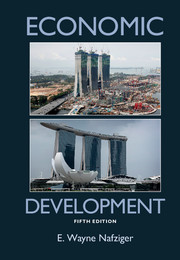Book contents
- Frontmatter
- Contents
- Preface to the Fifth Edition
- Abbreviations and Measures
- Part One. Principles and Concepts of Development
- 1 How the Other Two-Thirds Live
- 2 What Is Economic Development?
- 3 Economic Development in Historical Perspective
- 4 Characteristics and Institutions of Developing Countries
- 5 Theories of Economic Development
- Part Two. Poverty Alleviation and Income Distribution
- Part Three. Factors of Growth
- Part Four. The Macroeconomics and International Economics of Development
- Part Five. Development Strategies
- Glossary
- Bibliography
- Index
- Endpapers
1 - How the Other Two-Thirds Live
from Part One. - Principles and Concepts of Development
Published online by Cambridge University Press: 05 June 2012
- Frontmatter
- Contents
- Preface to the Fifth Edition
- Abbreviations and Measures
- Part One. Principles and Concepts of Development
- 1 How the Other Two-Thirds Live
- 2 What Is Economic Development?
- 3 Economic Development in Historical Perspective
- 4 Characteristics and Institutions of Developing Countries
- 5 Theories of Economic Development
- Part Two. Poverty Alleviation and Income Distribution
- Part Three. Factors of Growth
- Part Four. The Macroeconomics and International Economics of Development
- Part Five. Development Strategies
- Glossary
- Bibliography
- Index
- Endpapers
Summary
Development economics investigates the causes of poverty and low income around the world and seeks to make progress in designing policies that could help individuals, regions, and countries to achieve greater economic prosperity. (Acemoglu 2010:17)
In 1966, Ethiopia, India, and Thailand were all poor countries, [in which] a majority of people were living on less than $1 a day (in 1985 prices).…India did well, doubling per capita income between 1966 and 1990, and reducing poverty to 53 percent of the population.…Thailand did very well, tripling per capita income and cutting poverty to just 2 percent.…In 1966 Thailand had about four times Ethiopia's per capita income. By 1990 Ethiopians had seen no income growth, and Thailand was more than 10 times wealthier.…This difference is what Robert Lucas means by the “staggering consequences for human welfare” of different rates of growth and development. (World Bank 1998:29)
Nature and Scope of the Text
This book is about the economics of developing Asia, Africa, Latin America, and East and Central Europe, whose peoples include impoverished peasants, factory workers, small farmers, landlords, business people, managers, technicians, government officials, and political elites. The economics of development also includes lessons from the past economic growth of today's industrialized countries and middle-income economies.
- Type
- Chapter
- Information
- Economic Development , pp. 1 - 13Publisher: Cambridge University PressPrint publication year: 2012



